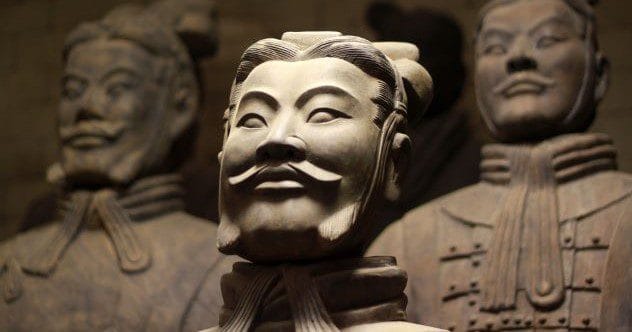When delving into the history of China, one cannot glance over the years from 206 BC to AD 220 without being impressed at the sheer ingenuity of the time and the impressive reign. As only the second great imperial dynasty in Chinese history, the Han Dynasty was known for its technological advancements and its development of various instrumental administrative structures used to refine the government of the time as the Chinese cemented their heritage in the most spectacular ways. A flourishing textile industry, effective civil service development, and even the creation of Chinese folk songs and poetry helped form the East into what it is today.
But 400 years is a long time, and there is much to learn and know about the Han Dynasty, how it was formed, and how it shaped history as we know it. In fact, the effects are still felt around Chinese culture to this day. Here are ten insane facts about the Han Dynasty that you probably didn’t know.
They Invented the Wheelbarrow
You might have thought the invention of the wheelbarrow followed shortly after the invention of the wheel, but you would be wrong.
As simple an invention as it is, the wheelbarrow, to this day, is one of the most used tools in any garden shed or building site around the world. And it all came from the most humble of beginnings. A man named Zhuge Liang is considered its inventor, and it wasn’t long after its invention that it was used for military purposes, transporting injured soldiers and supplies, although the original required two men to steer.
Wall paintings of a man using a wheelbarrow have also been found in Chengdu, Sichuan Province, dated to around AD 118, with another carving on a wall close by dating back to the year AD 147. [1]
The First Emperor Was a Peasant
Liu Bang, Emperor Gaozu of Han, was born a peasant. In his early days, he served the emperor of the time, Qi Shi Huangdi, carrying out his orders. One day, when transporting prisoners to the mausoleum, he found a common cause with the captured and became an outlaw rebel himself.
There are many myths surrounding his ascension—that there was a storm during his birth, that he encountered a dragon at some stage in his life, and that he was the descendent of the Mythical Emperor. But one thing is certain; he was at the right place and time.
Following the emperor’s death, the Qin Dynasty saw two ascendants to the throne, which fragmented the empire and paved the way for a collapse. Ultimately, this resulted in the territories being divided. Liu became the leader of the isolated Bashu region, a place mostly used for exiles and prisoners, not future emperors. But fate is a strange fellow. In the end, Liu defeated all contenders in a four-year power struggle to become Emperor Gaozu and claim his rightful dragon-blessed throne. [2]
Changed Warfare Forever
Until AD 9, people used to charge each other with sharp, pointy things, stabbing and swinging in the hopes of ending lives and being the last one standing on the battlefield… or until victorious.
Then, the Han Dynasty turned warfare on its head and invented something that went boom. Since its discovery, gunpowder has been used in the overwhelming majority of weapons. It is even a key component of such a simple and deadly ranged weapon that people carry it tucked into their belts under their shirts.
Invented by monks, ironically the most docile, peace-loving members of society, on their quest to create a life-extending elixir, gunpowder was almost immediately applied to warfare. And the human race has never looked back. [3]
First to Make Paper
With the mainstream acceptance of computers, traditional print media has struggled for relevancy, and our publishing landscape has changed. However, to this day, paper remains an important part of our society.
When Ts’ai Lun, a court official, used rags (or textile waste) to make paper, there was no knowing the impact it might have on the future of humanity or the effect it might have on how we communicate and record history. The end product and its uses took off like a hurricane.
After its invention in AD 105, paper enabled China to develop its civilization swiftly, although, as expected, there were some problems. Production was an arduous, time-consuming process that led to supply issues. The world caught on, and soon after, mechanization streamlined the process. [4]
Eunuchs Were Important Figures
Historians date the first appearance of eunuchs in court to around the same time as the Han Dynasty, which afforded them roles of varying importance. They found themselves in places of power where they could influence emperors and gain some form of control over state decisions and affairs.
The men who were mutilated at a young age served as palace menials, watchdogs for the emperor’s harem, and even acted as spies for their beloved leaders.
Seeing that the eunuchs were rendered sterile, they were authorized to adopt sons, allowing them to establish their own families within the inner court. This also formed the basis of their power and wealth. This led to some eunuchs even challenging sovereignty (like the chief eunuch Zhang Rang, who kidnapped a teenage emperor). [5]
Silk Had Immense Value
Silk remains an extravagant textile in the world of the flashy and the elite, used in fashionable garments the world over.
Dating back to 2696 BC, silk has been considered a valuable item for many years. However, it was during the Han dynasty that the value of silk took on a new meaning. A Chinese official, Zhang Quian, established a trade route that stretched from Asia through India, Persia, Arabia, Greece, and all the way to Italy—a route now known as the Silk Road.
It is believed that silk was even used to ward off a potential attack from invaders when they were offered more than 30,000 bolts of silk, 16,931 pounds (7,680 kilograms) of silk floss, and 370 pieces of clothing. [6]
Prosperous Early Days
The Han adopted the ideology of Confucianism, which emphasizes moderation, virtuous behavior and thought, and filial piety, thereby masking the authoritarian policies of the regime. This and a happy populace made the Han the longest-lasting Chinese Empire in history, establishing the rule for more than 400 years. Eleven members of the Liu family stepped into the shoes of the Gaozu emperor.
For the first 2,000 years of China’s history, the population remained stagnant between 10 and 20 million, but during the Han dynasty, the population ballooned, increasing to 59 million.
They were also protected from outside threats, as the centralized state that had been established was able to mobilize and face the threats of the barbarians, particularly the Huns, and fend them off. [7]
Empires Always Fall
Ruling a nation is hard, and there always seem to be problems along the way.
The Eastern Han was peppered with challenges from disasters outside their control, including cattle plagues, droughts, locusts, earthquakes, and floods, slowly chipping away at their reserve. In the end, the empire split into three separate kingdoms ruled by various warlords.
To make matters worse, there were outsiders, those that lived on the fringes of the Han Empire, tribal groups, and factions looking in, hoping to find chinks in the armor of the Han. A failure to integrate these tribes, combined with the state coffers running empty, meant that the state had no resources or plan to solve the problems. It was the beginning of the end. [8]
The Battle of Red Cliffs
By the end of the Han Dynasty, the empire had fragmented to such a state that war was staring them in the face.
The Battle of Red Cliffs was one of the most infamous and sizable single battles in the history of the world. It was a turning point engagement between Northern China, led by warlord Cao Cao, and the allied defenders of the south under Liu Bei. They fought, amassing casualties on both sides.
Cao Cao, who commanded the largest army in the region, was forced to retreat after suffering heavy losses. In turn, Liu Bei and Sun Quan stabilized their regions, ultimately leading to the Three Kingdoms Period, which followed after the end of the Han Dynasty. The Three Kingdoms remained in a shaky truce with each other until they were united under the Jin dynasty. [9]
The Majority of Chinese Population
Today, China’s population is estimated to be around 1.4 billion people. Within this enormous number are 56 ethnic groups with their own values, cultures, and traditions.
In fact, the Han rule was so impressive that 92% of the entire population of China still considers themselves part of the Han ethnic group, making it the largest group by far, with the remaining 55 ethnic groups collectively comprising less than 8%. The Zuang is the largest ethnic minority group, with a population of more than 15 million.
Distributed all over China, the Han people have their own language, which is also China’s national language. [10]
The Han Dynasty was a period of immense innovation and cultural development in China. From inventing the wheelbarrow and paper to shaping warfare with gunpowder, their impact is still felt today. Understanding these fascinating aspects of their history provides insight into the foundations of modern Chinese society.
What do you think about these interesting facts? Leave your comment below!










